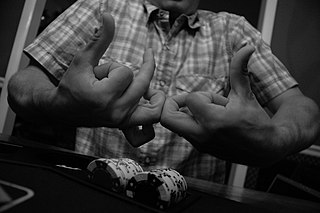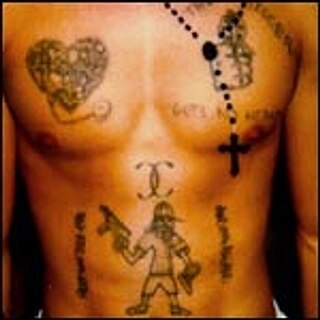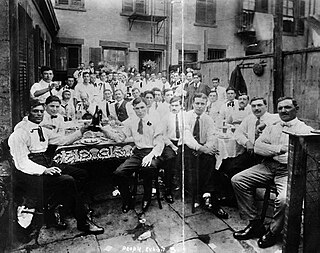A drug cartel is a criminal organization composed of independent drug lords who collude with each other in order to improve their profits and dominate the illegal drug trade. Drug cartels form with the purpose of controlling the supply of the illegal drug trade and maintaining prices at a high level. The formations of drug cartels are common in Latin American countries. Rivalries between multiple drug cartels cause them to wage turf wars against each other.

The Bloods are a primarily African-American street gang founded in Los Angeles, California. The gang is widely known for its rivalry with the Crips. It is identified by the red color worn by its members and by particular gang symbols, including distinctive hand signs.
A gangster is a criminal who is a member of a gang. Most gangs are considered to be part of organized crime. Gangsters are also called mobsters, a term derived from mob and the suffix -ster. Gangs provide a level of organization and resources that support much larger and more complex criminal transactions than an individual criminal could achieve. Gangsters have been active for many years in countries around the world. Gangsters are the subject of many novels, films, television series, and video games.
The Black Mafia, also known as the Philadelphia Black Mafia (PBM), Black Muslim Mafia and Muslim Mob, was a Philadelphia-based African-American organized crime syndicate. The organization began in the 1960s as a relatively small criminal collective in South Philadelphia, known for holding up neighborhood crap games and dealing in the illegal drug business, but at its height of operation in the early 1970s until about the early 1980s, it managed to consolidate power and control a large portion of criminal activity in various African-American neighborhoods throughout Philadelphia and the Delaware Valley, including South Jersey, Chester, and Wilmington. In addition to drug trafficking, burglary, and armed robbery, the Black Mafia was also engaged in traditional organized crime activities such as political corruption, extortion, racketeering, prostitution, loansharking, number running, and other illegal gambling rackets.

The Crips are an alliance of street gangs that is based in the coastal regions of Southern California. Founded in Los Angeles, California, in 1969, mainly by Raymond Washington and Stanley Williams, the Crips began as an alliance between two autonomous gangs, and developed into a loosely connected network of individual "sets", often engaged in open warfare with one another. Its members have traditionally worn blue clothing since around 1973.
Serbian organized crime or Serbian mafia are various criminal organizations based in Serbia or composed of ethnic Serbs in the former Yugoslavia and Serbian diaspora. According to the Criminologs and Police experts The Serbian Mafia is the most powerful in Europe.
The East Harlem Purple Gang was a gang or organized crime group consisting of Italian-American hit-men and heroin dealers who were semi-independent from the Italian-American Mafia and, according to federal prosecutors, dominated heroin distribution in East Harlem, Italian Harlem, and the Bronx during the 1970s and early 1980s in New York City. Though mostly independent of the Italian-American Mafia and not an official Mafia crew, the gang was originally affiliated with and worked with the Lucchese crime family and later with the Bonanno crime family and Genovese crime family. It developed its "closest ties" with the Genovese family, and its remnants or former members are now part of the Genovese family's 116th Street Crew.
Organised crime in Nigeria includes activities by fraudsters, bandits, drug traffickers and racketeers, which have spread across Western Africa. Nigerian criminal gangs rose to prominence in the 1980s, owing much to the globalisation of the world's economies and the high level of lawlessness and corruption in the country.

Approximately 1.4 million people in the United States were part of gangs as of 2011, and more than 33,000 gangs were active in the country. These include national street gangs, local street gangs, prison gangs, outlaw motorcycle clubs, and ethnic and organized crime gangs.

Frank Larry Matthews, also known as Black Caesar, Mark IV and Pee Wee, was an American drug trafficker and crime boss who sold heroin and cocaine throughout the eastern United States from 1965 to 1972. He operated in 21 states and supplied drug dealers throughout every region of the country. The Drug Enforcement Administration (DEA) ranks Matthews as one of the top ten drug traffickers in U.S. history and he is estimated to have had US$20 million in savings.
Gang activity and associated crime is a long-standing concern in Denver, Colorado. The city's street gang activity received statewide attention in 1993 when a "Summer of Violence" increased public awareness of gang-related violence and led the state to enact harsh penalties for crime by juveniles. From 1992 to 1995, Denver had 331 murders: 95 in 1992, 74 in 1993, and 81 each in 1994 and 1995 In 1997 The first Gang to ever be indicted out of Colorado was the West Side Ballerz Posse WSBP a Chicano gang that resided in West Denver & branched off in Adams county in cities such as Commerce, Thornton, Brighton, Westminster & other surrouIn 1996, members of the FBI's Metro Gang Task Force (“MGTF”) were investigating suspected gang-related drug activity in Denver, Colorado. Specifically, MGTF was investigating members of the West Side Ballerz Posse whom it suspected were selling controlled substances and engaging in gang-related violence. As part of this investigation, a series of wiretaps were authorized in late 1996 against suspected members of this drug conspiracy. Gang-related crime has continued, as shown by the New Year's Day 2007 drive-by shooting of Broncos cornerback Darrent Williams by members of the Tre Tre Crips, an East Denver street gang. The Crips in the city have several sub-sets such as Tre Deuce (DOD), Tre Foe, 35 Outlaws and the Tre Tre Gangstas. In 2017, the city's police estimated that there were 38,000 gang members in Denver, affiliated with 220 gangs. The Rollin 30s or Tre Tre Crips still have a powerful presence in the Denver area. In 2017 there were an estimated 2000 Bloods and Crips from Denver. These gangs are in various locations including Five Points, East Denver, Commerce City, Englewood, Aurora, North-East Park Hill and Federal Heights. Crips and Bloods have been commonly sighted almost all over Denver, even in the suburbs outside the city.

The Brooklyn Camorra or New York Camorra was a loose grouping of early-20th-century organized crime gangs that formed among Italian immigrants originating in Naples and the surrounding Campania region living in Greater New York, particularly in Brooklyn. In the early 20th century, the criminal underworld of New York City consisted largely of Italian Harlem-based Sicilians and groups of Neapolitans from Brooklyn, sometimes referred to as the Brooklyn Camorra, as Neapolitan organized crime is referred to as the Camorra.
Organized crime in the Netherlands, sometimes called penose is the organised criminal underbelly in Amsterdam and other major cities. Penose usually means the organizations formed by criminals of Dutch descent. It is a slang word coming from the old Amsterdam Bargoens language.
British firms are organised crime groups originating in the United Kingdom.
The Greek mafia is the colloquial term used to refer to various organized crime elements originating from Greece. Indigenous organized criminal groups are well-entrenched in the largest Greek urban centers, particularly in Athens.

Project Wildfire was a nationwide, multi-agency investigation of various transnational criminal gangs in 2015 that resulted in the arrests of 976 individuals, representing 239 different organizations, in 282 cities in the United States mainland and Puerto Rico. Eighty-two firearms, 5.2 kilograms of methamphetamine, 7.8 kilograms of marijuana, 5.6 kilograms of cocaine, 1.5 kilograms of heroin, US$379,399, counterfeit merchandise with a suggested retail price of US$547,534 and five vehicles were also seized.
The 10th & Oregon Crew or 10th & O Gang, also known as the 10th & O Crew or 10th & Oregon Gang, is a predominantly Italian American gang and organized crime group operating in Philadelphia, Pennsylvania. Active since the 1960s, the gang is associated closely with but independent from the Italian-American Philadelphia crime family. It is primarily active in South Philadelphia and certain working-class Italian-American neighborhoods in nearby South Jersey.

Chicago is considered the most gang-occupied city in the United States, with 150,000 gang-affiliated denizens, representing more than 100 gangs. Gang warfare and retaliation is common in Chicago. Gangs were responsible for 61% of the homicides in Chicago in 2011.







